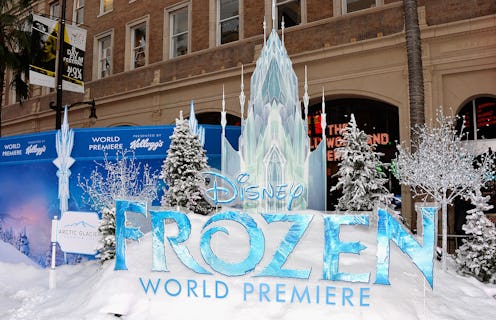Entertainment
No, 'Frozen' Does Not Have an Homage to 'Watchmen'
It feels like every day begins with a new "Let it Go" cover or Frozen mashup. Not that I'm complaining, I love a good multi-character Disney cover as much as the next millennial, and I have spent the odd Friday night combing through Youtube renditions of various Frozen ballads. Today, though, the fanart may have gone too far: Forrest Wickman, a Slate staff writer, just suggested that the "Let it Go" sequence in Frozen may be an homage to Dr. Manhattan's "Mars" scene in Watchmen.
I will agree that, on the surface, these two scenes seem similar. Both characters go into what Wickman describes as "distant, lifeless location[s]" and yes, they build very similar-looking crystal castles. But those visual cues are the end of the similarities between Elsa and Dr. Manhattan. I don't buy the idea that these two characters share much more than a predilection for building shiny things by themselves.
Sure, Elsa and Dr. Manhattan are both isolated from their supposed "peers" because they have special abilities, but they handle this isolation very differently. While Elsa worries about being able to express herself without hurting anyone, Dr. Manhattan contemplates the nature of the time-space continuum. Yes, he wonders if he's giving cancer to his ordinary lovers and friends, but part of Dr. Manhattan's unique deism is his distance from the problems of ordinary humans. His dispassion defines his interactions with people he supposedly "loves," while causing readers to wonder if he's capable of love at all.
Remember, during the original "Mars" panels of the comic book, he spouts off transcendental proverbs like, "Perhaps the world is not made. Perhaps nothing is made. Perhaps it simply is, has been, and will always be there." And although he brings his love, Laurie the Silk Spectre, up to visit his Martian creation, in a key moment of godlike aloofness, he forgets that she needs air. All the while, the blue superhero wonders if life is meaningless, ultimately deciding that thermodynamics give life meaning in one of the most philosophical comic panels of all time. So his moment on Mars is not exactly the same as an exiled teenager singing her heart out atop a mountain.
I will admit that Elsa also has trouble reconciling her powers with her need for human companionship, but instead of gaining new abilities in some sort of midlife "accident," Elsa, like Lady Gaga, was "born this way." Also unlike the big blue man-god, Elsa is clearly human, and her supernatural side is tied to her emotions. Sure, this may seem like a minor difference at first, but remember that both of these characters are situated in gendered contexts. While Dr. Manhattan is a god, his swinging blue penis constantly reminds readers and viewers that he is a (cis) male god. And although Elsa is a powerful character, her shiny blue dress reminds us that she is a traditionally femme woman.
Therefore, trying to paint the castle-building scene in Frozen as similar to the moment of glittering existential crisis in Watchmen leaves out the key, gender-based differences between the two films. Where Elsa must be controlled by her emotions, Dr. Manhattan has the freedom to float between emotional and emotionless. If only Frozen allowed Elsa moments of Manhattanesque philosophical clarity, I could believe in the homage.
But as it stands, the comparison between Watchmen and Frozen just reminds me of the limits placed on even the most empowered animated women.
